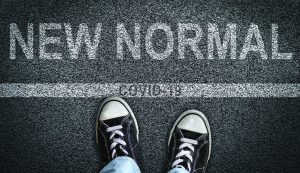It is the time honored way to deal with plagues and pandemics: those who have the means flee the crowds. In the past, Roman aristocrats would leave for their rural villas and summer homes; wealthy citizens left cities like Philadelphia during the 1793 Yellow Fever outbreak, leaving the poor behind to fend for themselves in the festering city.

While there have certainly been those who have escaped to less-dense areas of the country, the COVID-19 pandemic has witnessed the virtual version of this ancient practice: those who have been able to move their lives onto virtual networks have done so.
The COVID-19 pandemic has bifurcated the world of work. Some—like university professors, office workers, and other professionals—have been able to continue their working lives cocooned at home, virtually escaping the pandemic. For many others, work cannot be so easily conducted online, and so they have either been furloughed or laid off or have had to work in the increasingly dangerous “real world.”
What will our lives look like after COVID-19?
One possibility—the one many of us long for—is a return to something that looks like the status quo. But, as a historian looking at what the future will bring, it is more likely that we will retain habits and behaviors that we have been forced to learn because of the pandemic.
While we have already witnessed an explosion of face-to-face activity as the quarantines have been relaxed, this impulse to gather in large crowds might prove temporary. It is possible that, after an initial surge of physical gatherings, we will discover that we actually prefer meetings and other business carried out virtually.
Employees might argue that they were just as productive working remotely as they were banded together in an office. Companies might therefore continue to allow employees to work from home, saving the cost of renting or owning office space. Similarly,

conferences and business travel will likely be significantly reduced —assuming that the airlines even survive the coming pandemic-induced recession.
The economic consequences of the pandemic have led some to wonder whether globalization altogether might be under threat, in as much as globalization is defined in part by the ease of movement across international borders.
Telemedicine and online education —already practiced before the pandemic —will become more widely used. I do not believe that all of our lives will shift online, but we will discover that a greater portion of our lives will be conducted on-line. That is, the ratio of online-to-physical life will shift toward the former.
This will only be of benefit to a portion of the population, of course, with the technological capacity and the privilege of living and working online. Those who reside in rural areas or other “connectivity deserts” might find it difficult to move their lives online, with myriad social and economic consequences.
Four ways life may be different after COVID-19
• Virtual meetings may become the norm. Staley said that while people will enjoy meeting in person after quarantine rules are relaxed, that may prove temporary. It is possible that, after an initial surge of physical gatherings, we will discover that we actually prefer meetings and other business carried out virtually.
• We may want more personal space. You may have noticed that you feel a little uncomfortable when you see characters on TV shows hugging and shaking hands. Staley said that feeling probably won’t go away completely, even after the pandemic is over. We are very likely to expand the boundaries of our personal space.

• Large sporting and music events will be very different. Staley expects event organizers will limit the number of fans who can attend and will instruct them to arrive at the event at staggered times, to prevent a mass build-up at entrances. Similarly, there will be a schedule for when one can leave the stadium after an event.
• A new era of workers’ rights may be imminent. Staley admits that the “essential” workers who have received so much praise and attention during the pandemic may return to being underpaid and underappreciated laborers. Or they may be largely replaced by automation.
The physical spaces we move through will be redesigned to organize and control movement. Some retail establishments, for example, have been limiting the number of people who may be in the store at any given time, and some grocery store chains have taken to drawing lines on the floor that demark the approved path one must follow while in the store.
Before COVID-19, urban densification was all the rage among urban planners and advocates. Now I wonder if people will want to live in such dense conditions.
Whether at work or home, a lasting consequence of the COVID-19 pandemic will be a widening gulf in our lives between the bifurcated virtual and physical worlds.
Source: http://origins.osu.edu


